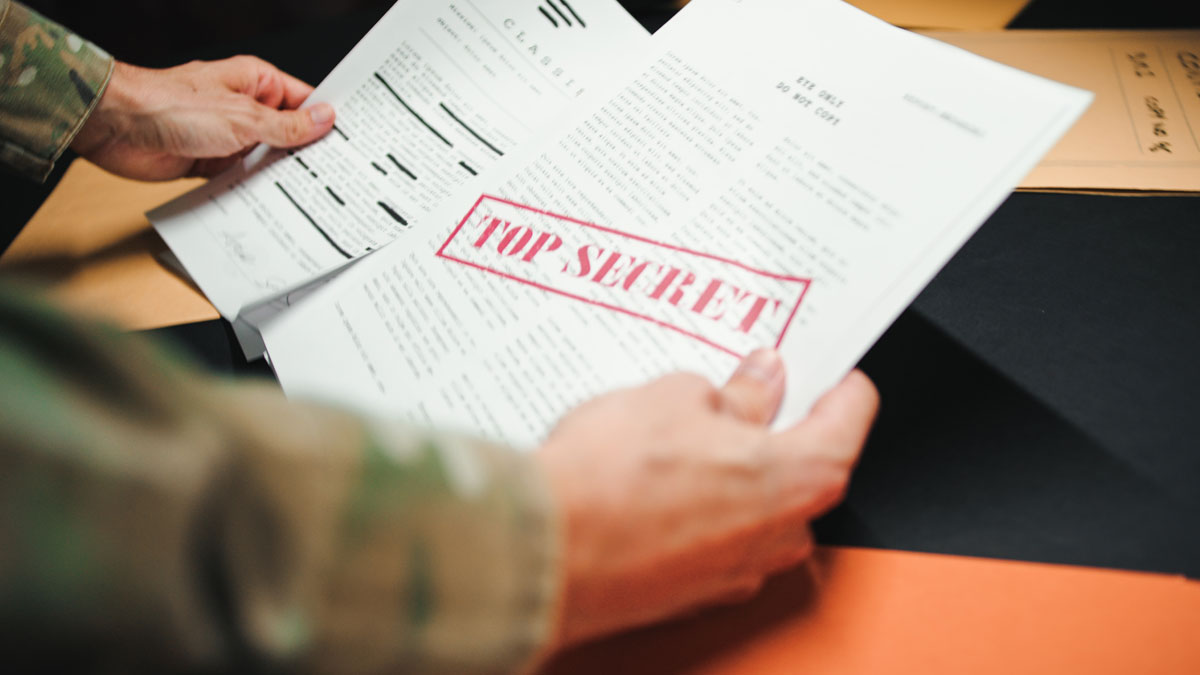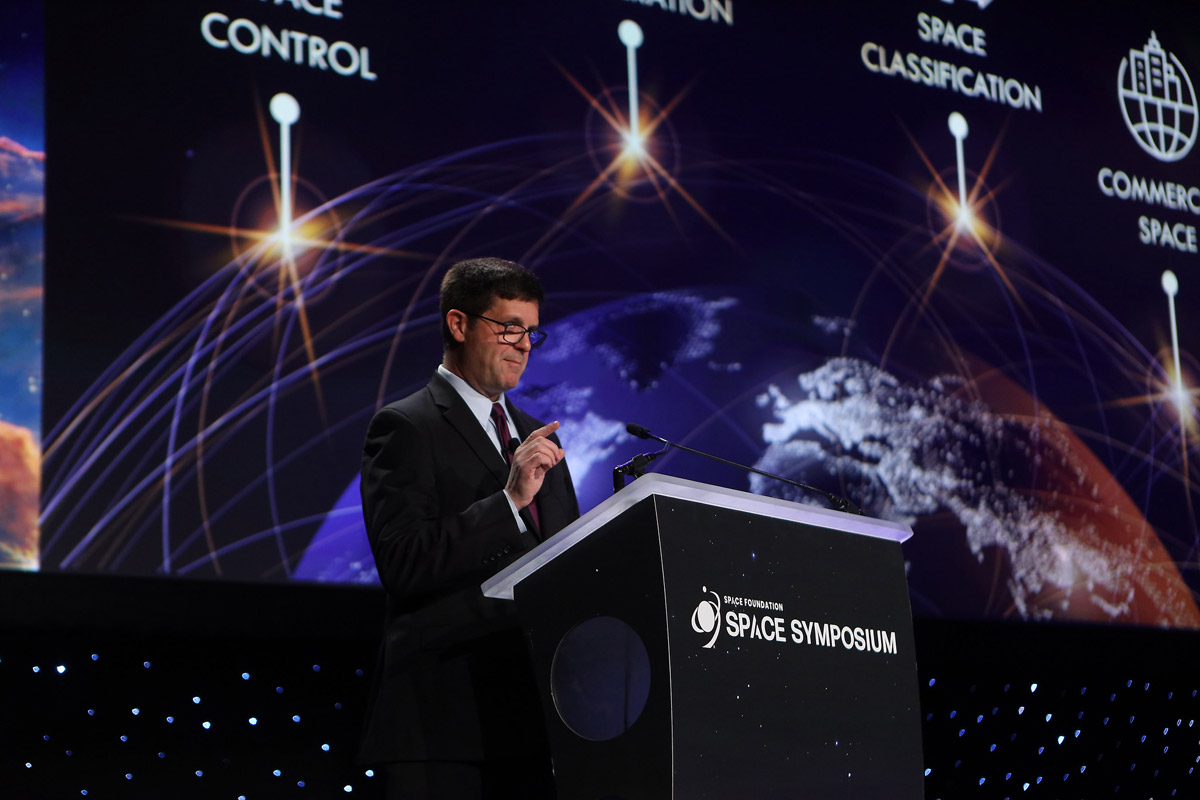
COLORADO SPRINGS, Col. — Overclassification of military space activities has been a source of frustration for U.S. military allies and industry partners for years. As the United States looks for support from allies and industry to address the growing number of threats in space, Pentagon officials say there is finally progress being made to roll back decades of excessive classification.
“Across the Pentagon, there is now a concerted effort to decrease the siloed nature of space activities,” said outgoing U.S. Assistant Secretary of Defense for Space Policy Dr. John Plumb. “Services are reviewing programs to reduce their classification to a level that benefits the warfighter. And we are leaning forward on how much we can share with our allies and partners, including industry, to allow more meaningful cooperation.”
The effort is taking place under a policy directive enacted late last year by Deputy Secretary of Defense Kathleen Hicks to eliminate the overuse of legacy classification barriers that officials say have hindered cooperation in the space domain between the U.S., allied nations and industry. Specifically, the changes encourage Pentagon leaders to reconsider using Space Access Programs (SAP) status, a designation intended to strictly limit highly sensitive information to only a small number of cleared persons.
After four months of the new policy, officials see declassification efforts beginning to move in the right direction, but it is only the beginning of a longer institutional change.
The goal is to use SAP only for programs that require that level of classification and take other programs down to Top Secret or below when appropriate, according to Plumb. This will not only help integration efforts with allies and commercial partners, it will also support warfighter readiness by allowing information to flow across the joint force into war plans and CONOPS—rather than being siloed in an annex.
“This new policy that Secretary Hicks signed is enormously important for us,” said Commander of U.S. Space Command Gen. Stephen Whiting, noting the service continues to “struggle to have all the conversations we want to have” with partners and allies.
The next challenge is to operationalize the policy, Whiting continued. “We’ve signed the piece of paper … but now we’ve got to go do the hard work and the people who have that responsibility are the services and the acquisition organizations.”
Asked if he was satisfied with the pace of implementation, Whiting said his command would be in a better position to assess progress midyear.
While there appears to be buy-in from the Department of Defense, Plumb expressed some frustration with the pace of change within the intelligence community (IC). “We changed the policies DoD needs to change. There are some policies the IC needs to change.” Plumb cited inconsistencies in the classification of the same data from the same satellite depending on whether it is flown by DoD or the IC. “That is legacy nonsense,” he said. “We have to get over that, because all that does is strap a bunch of impediments” on the warfighter.
SDA Could Be ‘Primarily a Commercial Solution’
The need for improved information sharing is particularly relevant for Space Domain Awareness (SDA), where no single country or provider has the full scope of capabilities to monitor everything in space. The growth of commercially available SDA (and space situational awareness) solutions in recent years is increasingly seen as a boon to the information-sharing environment, helping to sidestep some classification issues inherent in government-owned and operated systems.
“There is a version of the world where we just use commercial providers and use that to share data with our allies and partners because it solves the classification problem kind of by a dodge,” Plumb said in a response to a question from Constellations. “The ideal outcome would be the ability to combine U.S. classified sources … with commercial providers all into one larger solution that we can then share.”
 U.S. Assistant Secretary of Defense for Space Policy Dr. John Plumb addresses the 39th Annual Space Symposium, April 10, 2024, in Colorado Springs, Col. (Source: Space Foundation)
U.S. Assistant Secretary of Defense for Space Policy Dr. John Plumb addresses the 39th Annual Space Symposium, April 10, 2024, in Colorado Springs, Col. (Source: Space Foundation)
Two U.S. commercial SDA providers who spoke to Constellations on background confirmed the advantages of using unclassified sensors and platforms for more seamless military-to-military information sharing. Both were hopeful that recent revisions in U.S. classification of space activities will support deeper collaboration and integration among the military and commercial space.
Recent commercial space strategy documents categorized SDA as a hybrid mission area, open to commercial or military solutions. Increasingly, however, Space Force leaders have signaled strong demand for commercial SDA capabilities, like tracking, data fusion and analytics. Plumb hinted that while government resources are effective, “in the future, it could be primarily a commercial solution, because the commercial operators are doing such a good job.”
Closing the ‘Say-Do’ Gap
Recent steps to roll back classification practices follow a growing chorus of complaints from industry and international allies about U.S. military practices. In a recent report addressing challenges in U.S. military space collaboration, analysts with the Rand Corporation noted that U.S. allies “have grown increasingly vocal about a ‘say-do gap’ between U.S. high-level policy statements versus tangible U.S. cooperation on defense-related space activities.”
Policy statements may emphasize the strategic importance of collaboration, information sharing and interoperability, but policy in practice often limits access, often despite formal agreements. Several close U.S. allies interviewed in the Rand report cited poor communication as a barrier to understanding U.S. space priorities and enabling strategic investments in capabilities for a more cohesive, international approach to the domain.
“Classification is an obstacle to exchange information, but I’m not sure it’s the only one,” Col. Jean-Baptiste Paing C4ISR Capabilities Senior Architect for the French Ministry of the Armed Forces told Constellations in a brief interview. “You have to have reciprocity. You have to have confidence. You need multiple factors in order to afford [information sharing].”
In addition to reducing classification barriers, other efforts are underway to enhance cooperation. Military leaders from the United States and 17 nations convened on April 11 for the Space Chiefs Forum, which focused on assessing the space security environment, evaluating new cooperative concepts and discussing multilateral steps to maintaining the safety, stability and sustainability of the domain. The U.S. also invited three new allies, Germany, France and New Zealand, to join Operation Olympic Defender (OOD), a multinational effort to strengthen allied defenses and deter hostility in space.
Explore More:
Podcast with Col. Michael Christensen: Playing Poker, Changing Mindsets and Space Superiority
Space Force Outlines 4 Criteria for Commercial Space Technology
‘Free the Data’: SSC Calls for Greater Info-Sharing Among Allies
New Tech, New Partnerships: Highlights from DoD Space Leaders
